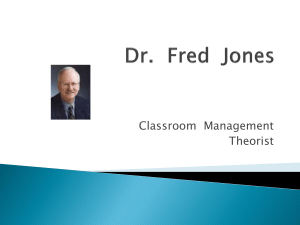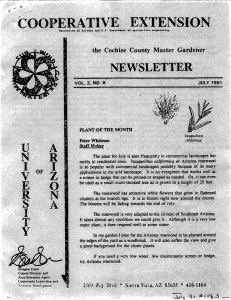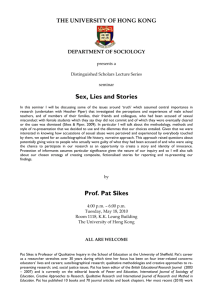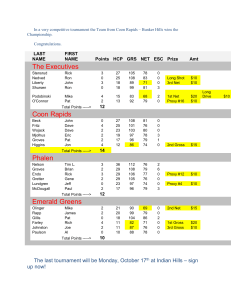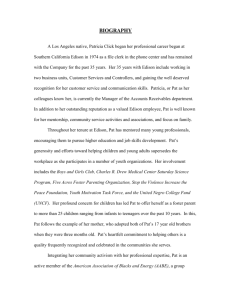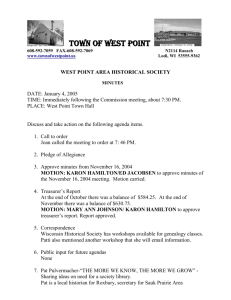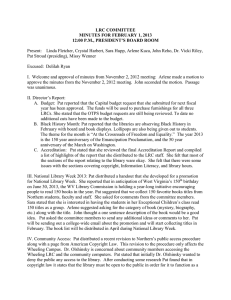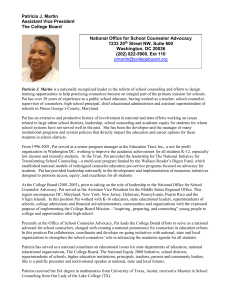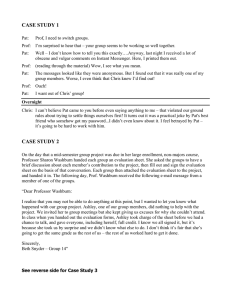Revisiting Classroom Management
advertisement
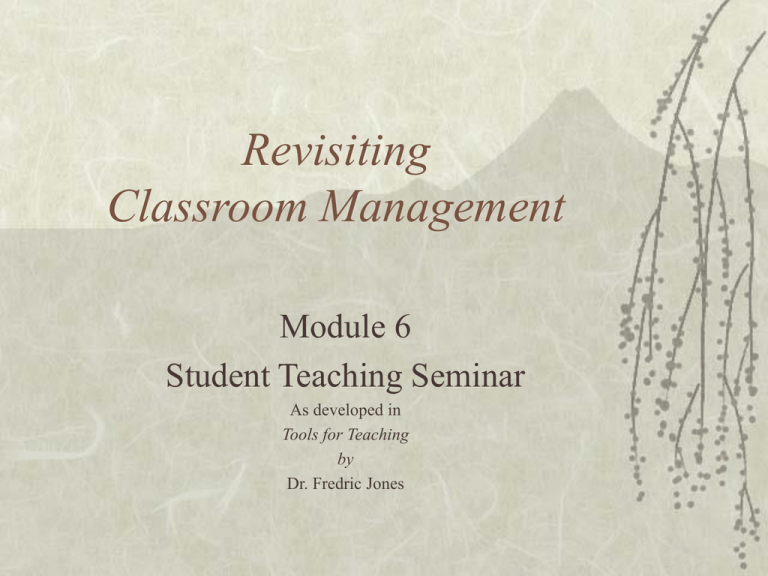
Revisiting Classroom Management Module 6 Student Teaching Seminar As developed in Tools for Teaching by Dr. Fredric Jones Respond To Several of These: To keep students on task, I have them turn in about half of their homework before the period ends. What other ways can I keep them on task without having to run off hundred of copies every day.? Is it appropriate of me to implement a corporate kind of rule – that is if one student messes up, the whole class suffers, but if one student does something good, then the whole class gets rewarded? I have tried calling names at random many times. I thought this would create suspense, motivating students to be quiet, pay attention, and get on task. It didn’t work. Why not? The kids in this school are just too rowdy. They figured out that I use proximity to keep them quiet and on task. Now, it doesn’t work nearly as well as when I started. What can I do? When a student is being openly and publicly rude to me, is it all right for me to reprimand the student in front of the whole class? How do I motivate the students to excel if the thing that keeps him from doing what’s right is that he is at this school and he badly wants to transfer out but can’t? What does it look like when a teacher mixes discipline and instruction? I am not sure whether I have done it or not, and I want to avoid it. Focusing On Prevention Traditionally we have referred to the skills of classroom management as a “bag of tricks.” Why is it necessary to have a classroom management system as opposed to “a bag of tricks?” What place will board or bell work take in your classroom? Why? How does “working the crowd” disrupt the disruptions? Provide camouflage for setting limits on disruptive behavior? Which Patterns of room arrangements are you going to use in your classroom? Why? Praise, Prompt, and Leave How many “helpless hand raisers” do you have in your class? How much of your time do they consume? What other types of “clinginess” are you experiencing? Describe Praise, Prompt and Leave beginning with the relaxing breath. Have you used it in your room? How has it worked? Exploiting the Visual Modality Reflect on the main characteristics of a good VIP. How do VIPs aid the weaning process? What are the various forms of VIPs that you have used this semester? Remember: VIP stands for Visual Instructional Plan Say-See-Do Principles The most efficient way to create comprehension and long-term memory during the teaching of a lesson is to teach one step at a time with a series of Say, See, Do cycles. The cognitive overload theory, typical of “Bop ‘til You Drop” feeds into the dependency of the helpless hand raiser. Structured Practice plays a major role in skill building. The Say-See-Do strategy can work for conceptual teaching as well. It is better to have students work in pairs than in groups of four. You can check students’ work during each Say, See, Do cycle in your subject area. Have you used SaySee-Do yet? What do you think? Calm Is Strength Are your management procedures working? How can you tell? What is meant by “calm is strength and upset is weakness?” Do you have any personal testimonies? Body Language: Meaning Business Turn in a Regal Fashion Turn from the top down in four parts: head, shoulders, waist, feet Point Your Toes Get a Focal Point Relax Your Arms Relax Your Jaw Two Relaxing Breaths Focus on passively waiting rather than “staring them down.” Describe how the body language of meaning business has worked (not worked) in your classroom. Responding to Balk Talk Should you receive backtalk (usually in response to a verbal prompt), take two relaxing breaths so you do not react emotionally. Let the words go “in one ear and out the other.” Wait until the student runs out of gas. The, wait some more. Direct the student back to work with a visual prompt if necessary. Be aware of the “last hurrah” and the “cheap shot” Has a student back talked to you yet? How did you respond? Responsibility Training Determine the time frame for giving PAT to your students, and build your daily schedule around it Explain PAT to your class Give the class a free PAT so that they know what you mean by PAT Ask the group if they would like to have PAT as part of their normal classroom routine Post your gift of PAT on the tally Explain bonuses to the class Explain dawdling and loss of PAT How have you implemented “Responsibility Training in your classroom? Omission Training Omission Training is the general name given to an incentive system that trains a person or group not to do something. How can you reinforce someone for not doing something? What are the key elements of your “heart-to-heart” with “that student.” Have you had that talk this semester? The Backup System Have you used the backup system yet? Describe. If you answered yes, why did the other parts of your management plan fail? Wrap-Up Dr. Jones classroom management procedures that are found in your Tools for Teaching book provide you with cheap and positive procedures for managing a range of problems that will arise in your classroom. If you ignore these timeless principles chances are you will have many problems in your classroom. If however, you apply the principles that you learned in the First Days of School Experience and are now practicing in your clinical setting, chances are you will manage an efficient and effective classroom.
